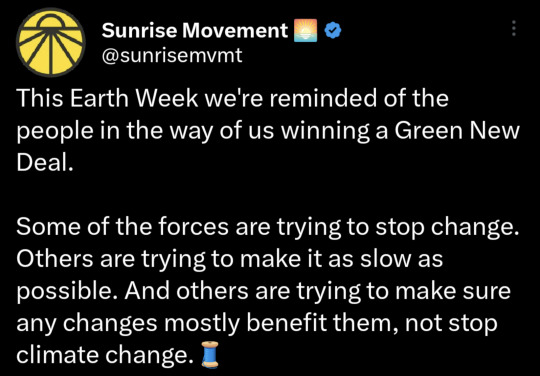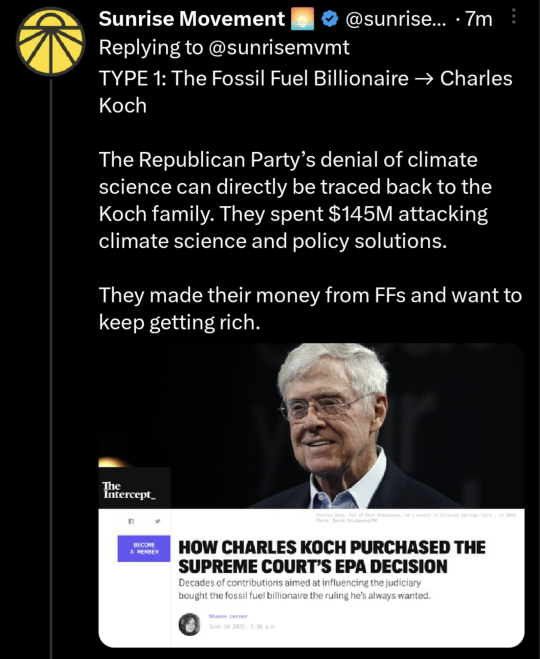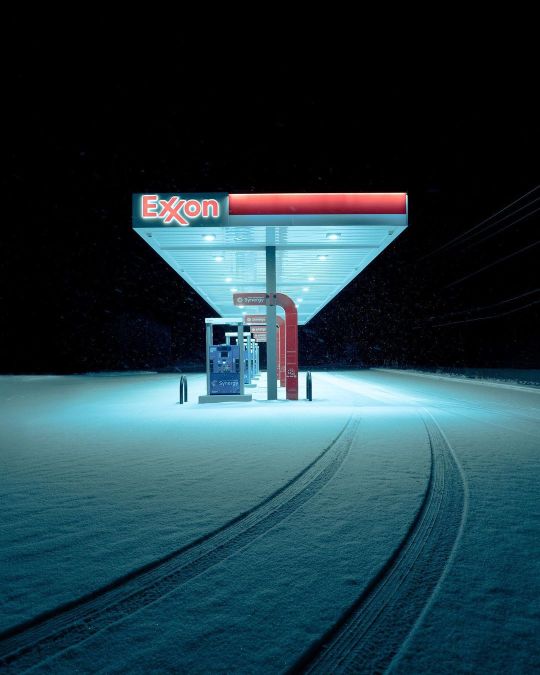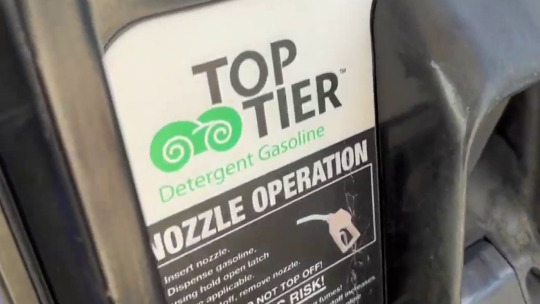#Exxon
Explore tagged Tumblr posts
Text
I was in a high rise apartment complex getting a manicure (I do not get manicures irl), and whales started attacking the Exxon gas station next door, causing it to explode. I was safe because I was in a high rise.
339 notes
·
View notes
Text

Happy Halloween from the latest addition to my collection of press photos of Protest Grim Reapers, or just death figures telling us what's up. This photo of a protester at Exxon's headquarters was taken by Michael Dinneen on July 26, 1989. If you still don't have a copy of the Public Collectors book Protest Grim Reapers, you can pick one up here.
#Public Collectors#Protest Grim Reapers#press photos#Michael Dinneen#Exxon#death figures#Earth First
82 notes
·
View notes
Text

Exxon tugboats escort the commercial tanker Exxon Valdez. A massive oil spill occurred when the vessel ran aground while transiting the waters of Prince William Sound in Alaska
Record Group 330: Records of the Office of the Secretary of DefenseSeries: Combined Military Service Digital Photographic Files
This photograph shows the Exxon Valdez, a large oil tanker, being towed by two smaller tugboats.
32 notes
·
View notes
Text
Electrons, not molecules

I'm on tour with my new, nationally bestselling novel The Bezzle! Catch me in TUCSON (Mar 9-10), then SAN FRANCISCO (Mar 13), Anaheim, and more!

When hydrocarbon barons do their damndest to torch the Earth with fossil fuels, they call us dreamers. They insist that there's a hard-nosed reality – humanity needs energy – and they're the ones who live in it, while we live in the fairy land where the world can run on sunshine and virtuous thoughts. Without them making the tough decisions, we'd all be starving in the frigid dark.
Here's the thing: they're full of shit.
Mostly.
Humanity does need energy if we're going to avoid starving in the frigid dark, but that energy doesn't have to come from fossil fuels. Indeed, in the long-term, it can't. Even if you're a rootin' tootin, coal-rollin' climate denier, there's a hard-nosed reality you can't deny: if we keep using fossil fuels, they will someday run out. Remember "peak oil" panic? Fossil fuels are finite, and the future of the human race needn't be. We need more.
Thankfully, we have it. Despite what you may have heard, renewables are more than up to the task. Indeed, it's hard to overstate just how much renewable energy is available to us, here at the bottom of our gravity well. I failed to properly appreciate it until I read Deb Chachra's brilliant 2023 book, How Infrastructure Works:
https://pluralistic.net/2023/10/17/care-work/#charismatic-megaprojects
Chachra, an engineering prof and materials scientist, offers a mind-altering reframing of the question of energy: we have a material problem, not an energy problem. If we could capture a mere 0.4% of the sun's rays that strike the Earth, we could give every person on the planet the energy budget of a Canadian (like an American, only colder).
Energy isn't just wildly abundant, though: it's also continuously replenished. For most of human history, we've treated energy as scarce, eking out marginal gains in energy efficiency – even as we treated materials as disposable, using them once and consigning them to a midden or a landfill. That's completely backwards. We get a fresh shipment of energy every time the sun (or the moon) comes up over the horizon. By contrast, new consignments of material are almost unheard of – the few odd ounces of meteoric ore that survive entry through Earth's atmosphere.
A soi-dissant adult concerned with the very serious business of ensuring our species isn't doomed to the freezing, starving darkness of an energy-deprived future would think about nothing save for this fact and its implications. They'd be trying to figure out how to humanely and responsibly gather the materials needed for the harvest, storage and distribution of this nearly limitless and absolutely free energy.
In other words, that Very Serious, Hard-Nosed Grown-Up should be concerned with using as few molecules as possible to harvest as many electrons as possible. They'd be working on things like turning disused coal-mines into giant gravity batteries:
https://www.euronews.com/green/2024/02/06/this-disused-mine-in-finland-is-being-turned-into-a-gravity-battery-to-store-renewable-ene
Not figuring out how to dig or flush more long-dead corpses out of the Earth's mantle to feed them into a furnace. That is a profoundly unserious response to the human need for energy. It's caveman shit: "Ugh, me burn black sticky gunk, make cave warm, cough cough cough."
Enter Exxon CEO Darren Woods, whose interview with Fortune's Michal Lev-Ram and editor Alan Murray contains this telling quote: "we basically focus our technology on transforming molecules and they happen to be hydrogen and carbon molecules":
https://fortune.com/2024/02/28/leadership-next-exxonmobil-ceo-darren-woods/
As Bill McKibben writes, this is a tell. A company that's in the molecule business is not in the electron business. For all that Woods postures about being a clear-eyed realist beating back the fantasies of solarpunk-addled greenies, Woods does not want a future where we have all our energy needs met:
https://billmckibben.substack.com/p/the-most-epic-and-literal-gaslighting
That's because the only way to get that future is to shift from molecules – whose supply can be owned and therefore sold by Exxon – to electrons, which that commie bastard sun just hands out for free to every person on our planet's surface, despite the obvious moral hazard of all those free lunches. As Woods told Fortune, when it comes to renewables, "we don’t see the ability to generate above-average returns for our shareholders."
Woods dresses this up in high-minded seriousness kabuki, saying that Exxon is continuing to invest in burning rotting corpses because our feckless species "waited too long to open the aperture on the solution sets terms of what we need as a society." In other words, it's just too late for solar. Keep shoveling those corpses into the furnace, they're all that stands between you and the freezing, starving dark.
Now, this is self-serving nonsense. The problem of renewables isn't that it's too late – it's that they don't "generate above-average returns for our shareholders" (that part, however, is gospel truth).
But let's stipulate that Woods sincerely believes that it is too late. It's pretty goddamned rich of this genocidal, eminently guillotineable monster to just drop that in the conversation without mentioning the role his company played in getting us to this juncture. After all, #ExxonKnew. 40 years ago, Exxon's internal research predicted climate change, connected climate change to its own profits, and predicted how bad it would be today.
Those predictions were spookily accurate and the company took them to heart, leaping into action. For 40 years, the company has been building its offshore drilling platforms higher and higher in anticipation of rising seas and superstorms – and over that same period, Exxon has spent millions lobbying and sowing disinformation to make sure that the rest of us don't take the emergency as seriously as they are, lest we switch from molecules to electrons.
Exxon knew, and Exxon lied. McKibben quotes Woods' predecessor Lee Raymond, speaking in the runup to the Kyoto Treaty negotiations: "It is highly unlikely that the temperature in the middle of the next century will be significantly affected whether policies are enacted now or 20 years from now."
When Woods says we need to keep shoveling corpses into the furnace because we "waited too long to open the aperture on the solution sets terms of what we need as a society," he means that his company lied to us in order to convince us to wait too long.
When Woods – and his fellow enemies of humanity in the C-suites of Chevron and other corpse-torching giants – was sending the arson billions to his shareholders, he held back a healthy share to fund this deceit. He colluded with the likes of Joe Manchin ("[D-POLLUTION]" -McKibben) to fill the Inflation Reduction Act with gifts for molecules. The point of fantasies like "direct air carbon-capture" is to extend the economic life of molecule businesses, by tricking us into thinking that we can keep sending billions to Exxon without suffocating in its waste-product.
These lies aren't up for debate. Back in 2021, Greenpeace tricked Exxon's top DC lobbyist Keith McCoy into thinking that he was on a Zoom call with a corporate recruiter and asked him about his work for Exxon, and McCoy spilled the beans:
https://pluralistic.net/2021/07/01/basilisk-tamers/#exxonknew
He confessed to everything: funding fake grassroots groups and falsifying the science – he even names the senators who took his bribes. McCoy singled out Manchin for special praise, calling him "a kingmaker" and boasting about the "standing weekly calls" Exxon had with Manchin's office.
Exxon's response to this nine-minute confession was to insist that their most senior American lobbyist "wasn't involved at all in forming policy positions."
McKibben points to the forthcoming book The Price Is Wrong, by Brett Christophers, which explains how the neoclassical economics establishment's beloved "price signals" will continue to lead us into the furnace:
https://www.versobooks.com/products/3069-the-price-is-wrong
The crux of that book is:
We cannot expect markets and the private sector to solve the climate crisis while the profits that are their lifeblood remain unappetizing.
Nearly 100 years ago, Upton Sinclair wrote, "It is difficult to get a man to understand something, when his salary depends on his not understanding it." Today, we can say that it's impossible to get an oil executive to understand that humanity needs electrons, not molecules, because his shareholders' obscene wealth depends on it.

Name your price for 18 of my DRM-free ebooks and support the Electronic Frontier Foundation with the Humble Cory Doctorow Bundle.

#pluralistic#bill mckibben#exxon#exxonknew#solarpunk#climate#climate emergency#climate crisis#gaslighting#guillotine watch#Darren Woods#incentives matter
239 notes
·
View notes
Text

Be sure to thank the Shareholders
#Be sure to thank the Shareholders#spain#valencia#shareholders#ausgov#politas#australia#climate change#global warming#science#co2 emissions#co2#pollution#auspol#tasgov#taspol#fuck neoliberals#neoliberal capitalism#anthony albanese#albanese government#climate crisis#climate action#climate justice#climate catastrophe#shell#bp#exxonmobil#exxon#mobil#pollutants
51 notes
·
View notes
Text

70 notes
·
View notes
Text





#Twitter#Sunrise movement#Earth week#Green new deal#Fossil fuel billionaire#Charles koch#Republican party#Koch#Ffs#Greenwashing billionaire#Elon musk#Tesla#Bought out politician#Joe manchin#Democrat#Exxon#Joe biden#Far right#Ron desantis#Florida#Elite
489 notes
·
View notes
Text


#least liked brands#2024#ranking#list#survey#information#companies#united states#data collection#methodology#Trump#Musk#Twitter#Fox#reddit#Sheim#Tik Tok#Exxon#Comcast#Dollar Tree#Temu#Boeing#Dollar General
25 notes
·
View notes
Text

Put a tiger in your tank!
#vintage illustration#vintage advertising#esso#exxon#esso extra#esso gasoline#esso extra gasoline#gas#gasoline#humble oil company#energy companies#petroleum companies#oil & gas#automotive products#gas stations#service stations#humble oil#humble oil & refinery company#corporate mascots#mascots#product slogans#product mascots
34 notes
·
View notes
Text
Interesting proposal by Nate Loewentheil in a guest column in The New York Times. Not only was his proposal thought provoking, but two of the comments regarding it by readers were also worth contemplating. Below are some excerpts from the column, followed by the two comments.
Here is a proposal for the environmental movement: Pool philanthropic funds for a day, buy a small plot of land in Washington, D.C., and put up a tall marble wall to serve as a climate memorial. Carve on this memorial the names of public figures actively denying the existence of climate change. Carve the names so deep and large, our grandchildren and great-grandchildren need not search the archives. This is not a metaphor. The problem with climate change is the disconnect between action and impact. If politicians vote against construction standards and a school collapses, the next election will be their last. But with climate change, cause and effect are at a vast distance. We are already seeing the consequences of our past and present greenhouse gas emissions. In coming decades, those emissions will wreak their full havoc on the climate, and it will take hundreds, possibly thousands, of years for those pollutants to fully dissipate. But in the short term, the most immediate burdens are borne mostly by the poor in America and distant people in distant lands. Misaligned incentives are at the heart of why some political and business leaders deny and delay. [...] I would first nominate those who have sown confusion over climate science, like Myron Ebell, who recently retired as director of the Competitive Enterprise Institute’s Center for Energy and Environment, where he sought to block climate change efforts in Congress, and served as the head of Donald Trump’s transition team for the Environmental Protection Agency. Mr. Ebell has argued that the idea that climate change is “an existential threat or even crisis is preposterous.” Then there are lawmakers who have consistently stood in the way of federal action, like the recently retired senator James Inhofe of Oklahoma, the author of the book “The Greatest Hoax: How the Global Warming Conspiracy Threatens Your Future.” [color emphasis added]
Below is the first thought provoking comment to this article:
There is, in Iceland, a memorial to a dead glacier - the Ok Glacier. It reads: "Ok is the first Icelandic glacier to lose its status as a glacier. In the next 200 years all our glaciers are expected to follow the same path. This monument is to acknowledge that we know what is happening and what needs to be done. Only you know if we did it." [color emphasis added] --Chris D., Colorado

Photo of the plaque at the at the Okjökull (OK Glacier) memorial.
Here is the second thought provoking comment to this article:
For reference this graph https://i.redd.it/ljifc828iui31.jpg is from the Exxon internal scientific report on climate change, 1982, produced by scientists working for that fossil fuel corporation. Look at what their graph predicted for 2020. Approaching 420 ppm CO2 and a rise of 1.2 C degrees above pre-industrial temperature - very close to what we actually got in 2020. Then look at what the graph shows for later this century, based on not reducing emissions. Very serious temperature rises, that could make agriculture very difficult in many countries. Yes, and then Exxon, having seen this, got involved in PR campaigns to "cast doubt" on climate science, to protect their assets. [color emphasis added] --Erik Frederiksen, Ashville, NC

1982 Exxon graph depicting average global temperature increases over time correlating with increases in atmospheric CO2. NOTE: Graph color was modified for greater clarity.
Fossil fuel companies like Exxon, and fossil fuel oligarchs like the Koch brothers should be included in any "Climate Wall of Shame."
#climate change#disinformation about climate change#climate change deniers#climate wall of shame#myron ebell#james inhofe#koch brothers#exxon#fossil fuel industry#ok glacier memorial#nate loewentheil#the new york times
71 notes
·
View notes
Text

1968 New Esso Guide To Heathrow Airport London
Source: Pinterest / Elza Marie
Published at: https://digitalposterarchive.com/petroleum/esso-ad-and-poster-collection/
7 notes
·
View notes
Text
Gas Station Stream of Consciousness Post
Gas Stations as Liminal Spaces

I've had quite a few hyperfixations in my day - ATMs, laundry detergents, credit cards - so my current one pertaining to gas stations is fitting considering my affinity for liminal spaces and the dedication of this blog to them. Liminal spaces are transitory in nature, hence their portrayal in online circles through photos of carpeted hallways, illuminated stairwells, dark roads, and backrooms, among other transitional points.

Gas stations are posted online as well; images of their fuel pumps or neon signage photographed through a rainy car window communicate their liminality and the universal experiences they provide to all of society. Perhaps they are the ultimate specimen of a liminal space. The machines they are created for, automobiles and tractor trailers alike, themselves are tools for motion, vestibules that enable travel and shipment across long distances at high speeds. Cars and roads are liminal spaces, albeit in different formats, and gas stations serve as their lighthouses. Vehicles at filling stations, therefore, are in a sense liminal spaces within liminal spaces within liminal spaces.

The uniqueness of a gas station as a liminal space, however, is its intersection with the economics and aesthetics of capitalism. Gasoline (and diesel fuel) is a commodity, downstream from crude oil, merely differentiated by octane ratings. Some argue that minute distinctions between agents, detergents, and additives make some brands better than others. Indeed, fuels that are approved by the Top Tier program, sponsored by automakers, have been shown to improve engine cleanliness and performance, but this classification does not prefer specific refiners over others; it is simply a standard. To a consumer, Top Tier fuels are themselves still interchangeable commodities within the wider gasoline commodity market.
The Economics of Gas Stations

The market that gas stations serve is characterized by inelastic demand, with customers who reckon with prices that fluctuate day in and day out. This is not to say that consumer behavior does not change with fuel prices. It has been observed that as prices rise, consumers are more eager to find the cheapest gas, but when prices fall, drivers are less selective with where they pump and are just happy to fill up at a lower price than last week. In response, gas stations lower their prices at a slower rate than when increasing prices, allowing for higher profit margins when wholesale prices fall. This has been dubbed the "rockets and feathers" phenomenon.

When portrayed as liminal spaces, gas stations are most often depicted at night, places of solitude where one may also enter the adjacent convenience store and encounter a fellow individual who isn't asleep, the modern day lightkeeper. The mart that resides at the backcourt of a gas station is known to sell goods at higher prices than a supermarket, simultaneously taking advantage of a captive customer, convenient location, and making up for the inefficiencies of a smaller operation. It may come as no surprise, then, that gas stations barely make any money from fuel sales and earn their bulk through C-store sales. This is a gripe I have with our economic system. Business is gamified, and in many cases the trade of certain goods and services, called loss leaders, is not an independent operation and is subsidized by the success of another division of a business, a strategy inherently more feasible for larger companies that have greater scale to execute it.

Nevertheless, most gas station owners, whether they have just one or hundreds of sites, find this method fruitful. Even though most gas stations in the US sell one of a handful of national brands, they operate on a branded reseller, or dealer, model, with oil companies themselves generally not taking part in the operations of stations that sell their fuels. The giants do still often have the most leverage and margin in the business, with the ability to set the wholesale price for the distributor, which sells at a markup to the station owner, which in turn will normally make the least profit in the chain when selling to the end customer at the pump. This kind of horizontal integration that involves many parties lacks the synergies and efficiencies of vertical integration that are so applauded by capitalists, but ends up being the most profitable for firms like ExxonMobil, who only extract and refine oil, and on the other end of the chain merely license their recognizable brands to the resellers through purchasing agreements. Furthermore, in recent years, independent dealers have sold their businesses to larger branded resellers, in many cases the ones from whom they had been buying their fuel.
A Word on ExxonMobil's Branding Potential

The largest publicly traded oil company in the world is Exxon Mobil Corporation. It is a direct descendent of the Rockefeller monopoly, Standard Oil, which was broken up in 1911 into 34 companies, the largest of which was Jersey Standard, which became Exxon in 1973. This title was generated by a computer as the most appealing replacement name to be used nationwide to unify the Humble, Enco, and Esso brands, decades before AI was spoken of. The latter brand is still used outside of the United States for marketing, arising from the phonetic pronunciation of the initials of Standard Oil. In 1999, Exxon and Mobil merged, and the combined company to this day markets under separate brands. Exxon is more narrowly used, to brand fuel in the United States, while Mobil has remained a motor oil and industrial lubricant brand, as well as a fuel brand in multiple countries.

Mobil originated in 1866 as the Vacuum Oil Company, which first used the current brand name for Mobiloil, and later Mobilgas and Mobilubricant products, with the prefix simply short for "automobile". Over time, Mobil became the corporation's primary identity, with its official name change to Mobil Oil Corporation taking place in 1966. Its updated wordmark with a signature red O was designed by the agency Chermayeff & Geismar, and the company's image for service stations was conceived by architect Eliot Noyes. New gas stations featured distinctive circular canopies over the pumps, and the company's recognizable pegasus logo was prominently on display for motorists.

I take issue with the deyassification of the brand's image over time. As costs were cut and uniformity took over, rectangular canopies were constructed in place of the special ones designed by Noyes that resembled large mushrooms. The pegasus remained a prominent brand icon, but the Mobil wordmark took precedence, which I personally believe to be an error in judgement. This disregard for the pegasus paved the way for its complete erasure in 2016 with the introduction of ExxonMobil's "Synergy" brand for its fuel. The mythical creature is now much smaller and appears only at the top right corner of pumps at Mobil gas stations, if at all.

Even into the 90s and the 21st century the Pegasus had its place in Mobil's marketing. In 1997, the company introduced its Speedpass keytag, which was revolutionary for its time and used RFID technology, akin to mobile payments today, to allow drivers to get gas without entering the store or swiping a card. When a Speedpass would be successfully processed, the pegasus on the gas pump would light up red.

When Exxon and Mobil merged in 1999, the former adopted the payment method too, with Exxon's less iconic tiger in place of the pegasus.

The program was discontinued in 2019 in favor of ExxonMobil's app, which is more secure since it processes payments through the internet rather than at the pump.

What Shell has done with its brand identity is what Mobil should've done for itself. The European company's logo was designed in 1969 by Raymond Loewy, and is a worth contender for the "And Yet a Trace of the True Self Exists in the False Self" meme. In recent years, Shell went all in on its graphic, while Mobil's pegasus flew away. I choose to believe that the company chose to rebrand its stations in order to prevent the malfunction in the above image from happening.

ExxonMobil should have also discontinued the use of the less storied Exxon brand altogether, and simplifying its consumer-facing identity to just the global Mobil mark. Whatever, neither of the names are actual words. As a bonus, here is a Google map I put together of all 62 gas stations in Springfield, MA. This is my idea of fun. Thanks for reading to the end!
#exxonmobil#exxon#mobil#gas station#gas stations#liminal space#liminal spaces#liminal#liminalcore#liminal aesthetic#justice for pegasus#shell#corporations#capitalism#branding#marketing#standard oil#economics#gas#gasoline#fuel#oil companies
110 notes
·
View notes
Text

#Oil#Weird#unusual#petrolium#crude oil#chevron#Oil sands#oil spill#drill baby drill#drilling rig#deepwater horizon#Kuwaiti oil fires#Chemicals#Ecosystems#Offshore oil platform#pipeline#exxonmobil#exxon#Exxon Valdez#clean up#spills#oil field#BP#OPEC
7 notes
·
View notes
Text

"The Fighting Hippie," Fake comic book cover by Danny Hellman for SLOW DEATH/LAST GASP COMIX 2/12/20
#art#illustration#illustrator#comics#cartoonist#exxon#oil#green#boomer#hippie#greenpeace#climatechange#gretathunberg#rockefeller#ronturner
2 notes
·
View notes
Text

Kamala Embraces Fossil Fuels: After All, Hurricanes Don’t Fuel Themselves!
#Kamala Embraces Fossil Fuels: After All#Hurricanes Don’t Fuel Themselves!#kamala harris#fossil fuels#hurricanes#global warming#pollution#co2 emissions#co2#extreme weather#oil#exxonmobil#exxon#mobil#bp#ausgov#politas#auspol#tasgov#taspol#australia#fuck neoliberals#neoliberal capitalism#anthony albanese#albanese government#climate change#climate crisis#climate action#climate justice#climate and environment
10 notes
·
View notes
